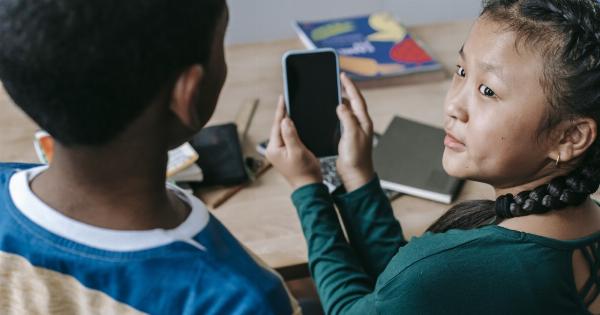The rapid advancement of technology has revolutionized the way we live, work, and communicate. With the emergence of smartphones, tablets, and various digital platforms, our children are increasingly spending a significant amount of time online.
While the internet offers countless opportunities for learning and entertainment, it is crucial for parents to help their children strike a balance between online and offline activities. In this article, we will explore some effective strategies to help your child maintain a healthy equilibrium between the digital world and the real world.
The Importance of Finding Balance
As parents, it is our responsibility to guide and support our children in their development. This includes monitoring and managing their screen time, ensuring that they engage in a diverse range of activities, both online and offline.
Finding balance is crucial for several reasons:.
1. Promoting Physical and Mental Well-being
Excessive screen time can lead to a sedentary lifestyle, which can result in various health issues such as obesity, poor posture, and sleep disturbances.
Encouraging your child to participate in offline activities like sports, outdoor play, reading, and socializing can help maintain their physical and mental well-being.
2. Enhancing Social Skills
While online platforms provide opportunities for social interaction, face-to-face communication and socializing in real-life scenarios are essential for developing vital social skills.
Encouraging your child to engage in offline activities will enable them to build and maintain healthy relationships, understand non-verbal cues, and develop empathy and compassion towards others.
3. Fostering Creativity and Imagination
Engaging in offline activities nurtures your child’s creativity and imagination.
Activities like drawing, painting, playing musical instruments, and storytelling allow children to think outside the box, express themselves freely, and develop their problem-solving skills.
4. Improving Academic Performance
Prolonged exposure to digital screens can be detrimental to your child’s academic performance.
Setting aside dedicated offline study time without any distractions can significantly improve their ability to concentrate, absorb information, and retain knowledge.
Strategies to Strike a Balance
Now that we understand the importance of finding balance, let’s explore some effective strategies to help your child achieve a healthy equilibrium between online and offline activities:.
1. Set Clear Boundaries and Expectations
Establishing clear boundaries and expectations regarding screen time is essential. Create a set of rules that outline when and for how long your child can use digital devices. Consistency is key, so make sure to enforce these rules consistently.
2. Be a Role Model
Children often emulate the behavior of their parents or caregivers. If you want your child to strike a balance, lead by example.
Limit your own screen time in front of your child, prioritize offline activities, and demonstrate the benefits of engaging in real-world experiences.
3. Encourage and Facilitate Offline Activities
Provide your child with a variety of offline activities to choose from. Encourage their interests and hobbies, whether it’s playing a musical instrument, engaging in sports, reading books, or pursuing arts and crafts.
Create a supportive environment that enables your child to explore and enjoy these offline activities.
4. Create Device-Free Zones and Times
Designate certain areas in your home as device-free zones, such as the dining table or bedrooms.
Establish specific times during the day when all family members, including yourself, are expected to disconnect from digital devices and engage in other activities or have quality time together.
5. Foster Outdoor Exploration
Encourage your child to spend time outdoors and explore nature. Plan regular family outings to parks, nature reserves, or beaches where they can engage in physical activities, discover new things, and appreciate the beauty of the natural world.
6. Engage in Family Activities
Family activities provide an excellent opportunity for bonding and promoting offline interactions.
Organize regular game nights, movie nights, or outings where the focus is on spending quality time together as a family without the intrusion of digital distractions.
7. Emphasize the Importance of Sleep
Ensure your child gets sufficient sleep by promoting healthy sleep habits. Discourage the use of electronic devices, especially before bedtime, as the blue light emitted by screens can interfere with sleep patterns.
Establish a consistent bedtime routine with relaxing activities that do not involve screens.
8. Educate on Internet Safety
Help your child understand the importance of internet safety. Teach them about the potential risks and hazards of engaging with strangers online, the importance of protecting personal information, and how to navigate the digital world responsibly.
Encourage open communication so that they feel comfortable seeking guidance or sharing any concerns they may have.
9. Monitor and Limit Screen Time
Utilize parental control features available on devices and software to monitor and limit your child’s screen time. Set age-appropriate restrictions, block access to inappropriate content, and track their online activities.
Regularly review and update these settings as your child grows and their needs change.
10. Be Mindful of Educational Opportunities Online
While it is essential to strike a balance, acknowledge the educational benefits of the online world. Guide your child towards reputable websites, educational apps, and online resources that enhance their learning.
Encourage them to explore educational content that aligns with their interests and helps them develop new skills.
Conclusion
The digital age offers unlimited possibilities for our children, but it’s crucial to guide and support them in navigating this ever-connected world.
By helping your child strike a balance between online and offline activities, you are equipping them with the tools necessary to make the most of both realms. Implementing the strategies mentioned above will foster their physical and mental well-being, enhance their social skills, foster creativity, and improve their academic performance.
It’s never too late to start instilling healthy habits and finding the delicate balance between the digital world and the real world.






























